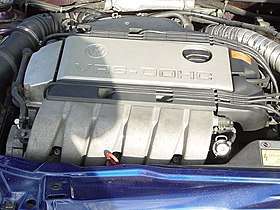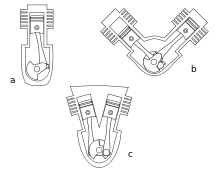VR6 engine
VR6 engines are V6 piston engines with a narrow angle between the cylinder banks and a single cylinder head covering both banks of cylinders.
| VR6 engine | |
|---|---|
 1991-1995 Volkswagen Corrado 2.9 litre engine | |
| Overview | |
| Production | 1991-present |
| Layout | |
| Displacement | 2.8–3.6 L (171–220 cu in) |
| Valvetrain | 1991-2002: 12 valves 2000-present: 24 valves |
| Combustion | |
| Fuel type | Petrol |
Volkswagen Group introduced the first VR6 engine in 1991 and VR6 engines currently remain in production. From 1997-2006, Volkswagen also produced a five-cylinder VR5 engine based on the VR6.
Description
The name VR6 comes from the German initials for a V engine (German: V-Motor) and a straight (inline) engine (German: Reihenmotor), therefore the VR engine is described as a "Vee-Inline engine" (VR-Motor).
VR6 engines shares a common cylinder head for the two banks of cylinders. Only two camshafts are needed for the engine, regardless of whether the engine has two or four valves per cylinder. This simplifies engine construction and reduces costs.
Since the cylinders are not located on the centreline of the combined cylinder head, the lengths of the intake and exhaust ports are different for each bank. Without compensation, these varying port lengths would result in the two banks of cylinders producing different amounts of power at a particular engine RPM. The difference in port lengths are compensated for with the length of the runners in the intake manifold, the camshaft overlap and lift profile, or a combination thereof.
Volkswagen engines

The Volkswagen VR6 engine was designed for transverse engine installations in front-wheel drive vehicles.[1] The narrow angle of 15° between the two cylinder banks reduced the width of the engine, compared to a traditional V6 engine. Therefore the VR6 engine is easier to fit within an engine bay that was originally designed for a four-cylinder engine.
12-valve versions
Early VR6 engines had two valves per cylinder (for a total of twelve valves) and used one camshaft for the intake and exhaust valves of each cylinder bank (without the use of rockers).
The first Volkswagen VR6 engine uses the AAA version. It had a bore of 81.0 mm (3.19 in) and a stroke of 90.3 millimetres (3.56 in), for a total displacement of 2.8 L (171 cu in). In 1994, a 2.9 L (177 cu in) ABV version was introduced in some European countries, with an increased bore of 82.0 mm (3.23 in).
The V angle between the cylinder banks is 15°, and the compression ratio is 10:1.[2] The crankshaft runs in seven main bearings and the journals are offset 22° to one another, in order to accommodate the offset cylinder placement.[3] This also allows the use of a 120° firing interval between cylinders.[4] The firing order is: 1, 5, 3, 6, 2, 4.[5] The centerline of the cylinders are offset from the centerline of the crankshaft by 12.5 mm (0.49 in).
The valve sizes are 39.0 mm (1.54 in) for the intake and 34.3 mm (1.35 in) for the exhaust. Since the two 'rows' of pistons and cylinders share a single cylinder head and head gasket, the piston crown (or top surface) is tilted. The engine management system is Bosch Motronic.
24-valve versions
A version with four valves per cylinder (for a total of 24 valves) was introduced in 1999.[6] The 24-valve versions use one camshaft for the intake valves of both banks (using rockers to reach the furthest bank) and the other camshaft for the exhaust valves of each bank (again, through the use of rockers).[7] This operating principle is more akin to a double overhead camshaft (DOHC) design, with one camshaft for intake valves, and one for exhaust valves.
History
The 1922-1976 Lancia V4 engine was the first narrow angle V engine to be used in a motor vehicle.[8][9]
The first versions of the VR6 engine were introduced in the 1991 Volkswagen Passat B3 sedan and Volkswagen Corrado coupe.[10] A 2.8 L (171 cu in) AAA version producing 128 kW (172 hp) was used in most Passat models and in the North American version of the Corrado. A 2.9 L (177 cu in) ABV version producing 140 kW (188 hp) was used in the Passat Syncro model and the European version of the Corrado. Both versions used 2 valves per cylinder. Usage of the VR6 engine spread to the Volkswagen Golf Mk3 2.8 VR6 and Volkswagen Vento/Jetta (A3) 2.8 VR6 models in 1992. The 2.8 litre version was also used in the 1996-2003 Mercedes-Benz Vito (W638) commercial vans, where it was designated as 'M104.900'.
In 1997, the VR5 engine was introduced, based on the VR6 engine.
An AQP/AUE version with 4 valves per cylinder was introduced in 2000. This 2.8 L (171 cu in) engine produced 150 kW (201 hp), and mostly replaced the 2 valve engines, except for in North America where an updated version of the 2 valve engine was used in the Golf and Jetta from 2000-2002.
A 3.2 L (195 cu in) EA390 version of the 4 valve engine was introduced in the 2001 Volkswagen New Beetle RSi model. This 3.2 litre engine was also used in the 2002-2004 Volkswagen Golf Mk4 R32 model and the 2003-2010 Audi TT 3.2 VR6 quattro models. Peak power output was 177 kW (237 hp) in the New Beetle and Golf (engine code BFH/BML), and 184 kW (247 hp) in the Audi TT (engine code BHE).
The engine size was again increased in 2005, when a 3.6 L (220 cu in) version with gasoline direct injection (FSI) was introduced in the Volkswagen Passat (B6). This BLV version uses a narrower 10.6 degree angle between the cylinder banks and produces 206 kW (276 hp). A 3.2 L (195 cu in) AXZ version producing 184 kW (247 hp) was introduced in 2006.[11] In 2008, an uprated BWS version of the 3.6 litre engine producing 220 kW (295 hp) was introduced in the Volkswagen Passat (B6) R36 model.[12]
The base model Porsche Cayenne (9PA) used 3.2-liter VR6 engine from 2003-2006 and then a 3.6-litre VR6 engine from 2008-2010. Then the next generation Porsche Cayenne (92A) also used a 3.6-litre VR6 engine from 2010-2018.
Volkswagen is currently phasing out VR engines in favour of downsized turbocharged engines, however the VR6 currently remains in production for the Volkswagen Passat (NMS) sedan models sold in China and the Volkswagen Atlas SUV.
Applications
Volkswagen Group automobiles:
- 1991-1995 Volkswagen Corrado
- 1991-2015 Volkswagen Passat B3, B4, B6 and B7 generations
- 1992-1998 Volkswagen Golf Mk3
- 1992-1999 Volkswagen Vento/Volkswagen Jetta Mk3
- 1995-2000 Volkswagen Sharan
- 1996-2003 Volkswagen Transporter (T4)
- 1996-2010 SEAT Alhambra (7M)
- 1999-2004 Volkswagen Golf Mk4
- 1999-2006 Volkswagen Bora/Volkswagen Jetta Mk4
- 2000-2004 SEAT León (1M)
- 2001-2003 Volkswagen New Beetle RSi
- 2002-2016 Volkswagen Phaeton
- 2002-2018 Volkswagen Touareg
- 2002-2018 Porsche Cayenne E1 and E2 generations
- 2003-2009 Volkswagen Transporter (T5)
- 2003-2013 Audi A3 (8P)
- 2003-2010 Audi TT Mk1 and Mk2
- 2005-2008 Volkswagen Golf Mk5 R32
- 2006-2011 Volkswagen Eos
- 2008-2017 Volkswagen CC
- 2008-2010 Škoda Superb (3T)
- 2008-2015 Audi Q7 (4L)
- 2011-2018 Volkswagen Passat NMS
- 2017-present Volkswagen Atlas
Other manufacturers:
- 1995-2000 Ford Galaxy Mk I
- 1996-2003 Mercedes-Benz Vito (W638)
- 1997-2005 Winnebago Rialta/Vista/Itasca
- 2009-2012 Artega GT[13]
- Linden Forklifts (fuelled by propane)
W engines
Volkswagen Group has produced several 'W engines' based on combining two VR engines on a common crankshaft. The first W engine to reach production was the W12 engine which has been produced since 2001. The W12 engine is constructed from two VR6 engines mated together at an angle of 72 degrees. Although Volkswagen has not produced a VR4 engine, nonetheless it briefly produced a W8 engine from 2001-2004.
The largest Volkswagen W engine is the W16 engine introduced on the Bugatti Veyron in 2005. This engine uses an angle of 90 degrees between the two VR8 engines, and has four turbochargers.
Other manufacturers
Motorcycle manufacturer Horex has produced VR6 engines since 2012.[14][15]
References
- "VW's V5 and VR6 engines". heritagepartscentre.com/uk/. 3 August 2017. Retrieved 19 November 2019.
- Clemens, Kevin. VW GTI, Golf, Jetta, MK III & IV. St. Paul, MN: Motorbooks International. p. 22. ISBN 0-7603-2595-2.
- Raven, Gregory; Erickson, Chad. Water-Cooled VW Performance Handbook: 3rd Edition. MBI Publishing. p. 41. ISBN 1610601998.
- Barber, Thomas. "Horex VR6 motorcycle". Motorcycle Daily. Retrieved 23 June 2014.
- Schenck, M (1991). Automotive Design Engineering. Century Press.
- "Volkswagen's VR6 Engine". www.automobilemag.com. Retrieved 20 November 2019.
- "R32 3.2 VR6 EA390 Engine Specifications". www.motorreviewer.com. Retrieved 19 November 2019.
- "Part I: V-engines". www.topspeed.com. Retrieved 20 November 2019.
- "Theme: Engines – Divine Inclination". www.driventowrite.com. 29 August 2014. Retrieved 20 November 2019.
- "VW's new 496bhp 3.0-litre VR6 engine". www.autocar.co.uk. Retrieved 20 November 2019.
- "The Passat (sales brochure) - 3.2 FSI VR6" (PDF). Volkswagen Group United Kingdom Limited. Volkswagen.co.uk. 1 December 2008. pp. 14, 18, 24. Retrieved 31 July 2009.
- "The Passat (sales brochure) - 3.6 FSI VR6" (PDF). Volkswagen Group United Kingdom Limited. Volkswagen.co.uk. 1 December 2008. pp. 11, 12, 14, 19, 24. Retrieved 31 July 2009.
- "2009 Artega GT - Review - Car and Driver". caranddriver.com. Retrieved 9 April 2018.
- "Horex VR6". www.roadandtrack.com. 24 May 2013. Retrieved 19 November 2019.
- "The Horex VR6 Raw is a V6 Two-Wheeled Monster". www.rideapart.com. Retrieved 19 November 2019.
| Wikimedia Commons has media related to Volkswagen VR6 engine. |